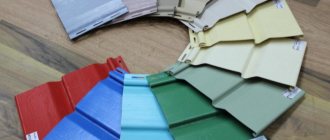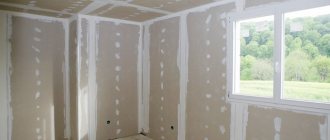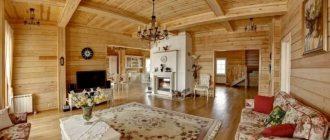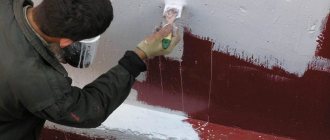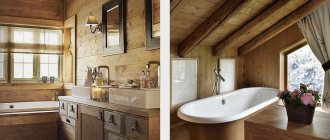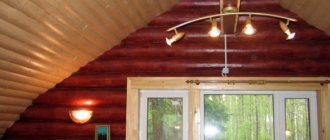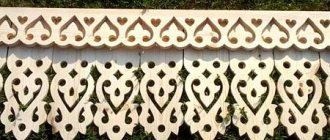The 21st century has arrived a long time ago, and wooden houses do not even think of going out of fashion. More precisely, it’s difficult to call it fashion. Rather, common sense, coupled with a subtle sense of taste, because what other natural material so organically combines environmental safety, reliability and home comfort? True, you won’t be able to escape from the interior decoration (read about how to insulate walls with polystyrene foam from the outside). This is an important component of any construction, and people often have a question: what can inexpensively and beautifully cover the inside of the walls with? Moreover, not every material is suitable for use in a wooden house. We have selected 6 excellent options for you that will definitely help you overcome your doubts and achieve optimal interior design.
- Lining;
- Drywall;
- Cork;
- Decorative rock;
- Plastic;
- Ceramic tile;
- Conclusion.
Lining
Another natural and budget material for finishing a country house interior.
It will fit perfectly into country style and will withstand temperature changes and humidity. The lining becomes wear-resistant and rot-resistant after applying special compounds. It can be installed on slightly convex or curved walls. The material can be painted, treated with stain, wax or oil, giving the desired natural shade. A more budget-friendly option is varnish, but over time it turns yellow. The layout of the elements can be any: diamond, herringbone, half wall. With the help of lining they decorate the ceiling or highlight certain zones.
Facing
Some interior design styles involve covering the walls with ceramic tiles or mosaics not only in the kitchen and bathroom, but also in other rooms. Several materials are used for these purposes.
- Natural stone is rare, but quite popular for fragmentary finishing in the fireplace area, doorways or on an accent wall.
- Artificial stone is a ready-made gypsum imitation, stylized as stone of various types, used not only in accent areas, but also as the main finishing material for walls, if not in the whole house, then in some rooms.
- Homemade imitation is the simplest and cheapest, and therefore a popular finish among private owners, attractive due to its accessibility and relative ease of work. Brickwork on the wall is imitated using gypsum plaster applied to the surface either through a stencil or over “seams” of masking tape. The relief is created using various available means, it can be a spatula with fingers, or a dry brush. After removing the tape or stencil and drying the “brick”, the surface is painted in one or more tones. Some also seal the seams for greater authenticity, but this is not for everyone and makes sense when the tiles are thick. Imitation of masonry is done in corridors, halls, and living rooms, and some even decorate bedrooms this way.
You can also try making an imitation using polymer molds, but this is much more expensive, but the result is practically indistinguishable from expensive collections of famous brands.
Board
Suitable for both wall decoration and floor covering. The main difficulty is to choose the right material: the boards should not be wet and, conversely, overdried. They look impressive after treatment with protective compounds, give a country house a special charm and fill the atmosphere with coziness.
For dacha floors, there are special boards that are laid using the tongue-and-groove technology. This is the most reliable connection that allows you to create a strong and even floor.
Brushed and barn boards are still in fashion, but despite its aged appearance, the finished material is quite expensive. To avoid costs, the elements can be processed yourself.
Step-by-step finishing instructions
The finishing of the second floor at the dacha can be done with eurolining. For this, it is best to use the lightest breeds, which include:
- ash;
- spruce;
- maple;
- fir.
This will increase the space on the second floor. The work will require slats, the width of which ranges from 5 to 15 cm. Before finishing the second floor in the dacha, you will need to fill a wall frame, between the elements of which a distance of 50 cm is maintained. When finishing the attic with clapboard, the cladding is fastened with small nails. The surface is covered with a protective layer, which can be mastic, stain or varnish.
When considering options for finishing the attic, you may want to make the dacha less monotonous. To brighten up the interior, you can use MDF panels, which will add harmony to the interior, and also make the walls and ceiling durable and warm. If desired, the floor can be covered with laminate, and the walls can be decorated with MDF panels coated with cork. Wooden baseboards will complement the attic.
The attic floor room in the ceiling area can be supplemented with beams, which will give the interior a unique and rustic flavor. A small attic can be lined with plywood from the inside. But if the room has high humidity, you should avoid using this material. But if the space is heated, you can also paste wallpaper. When decorating a dacha, you can give preference to cheap finishing materials, for example, paper.
Logs or block house
If the walls of a country house are built from logs, try not to hide the authentic beauty of the wooden walls. Logs are a surprisingly durable and reliable material, and after repair they will last for decades.
House panels are used to decoratively imitate log walls. From the outside, they have a semi-cylindrical shape and are fastened with a tongue-and-groove locking connection. A block house made of wood is used for the interior, and vinyl is used for the façade cladding.
Clinker thermal panels
One of the most modern materials for finishing a house outside are linker thermal panels. They are multi-layered:
- The bottom layer is thermal insulation. It is presented in the form of insulation: polystyrene foam or polyurethane foam, which have good thermal insulation.
- The top layer is decorative. Most often represented by clinker tiles, which have maximum strength and very high frost resistance. The tile very naturally imitates brickwork, makes the facade aesthetic and neat, and also protects the insulation from wind, precipitation and sunlight.
Joining clinker panels
Due to this structure, clinker thermal panels simultaneously act as both insulation and decorative finishing. This allows you to speed up the installation process, since the stage of covering with thermal insulation boards is skipped. The advantages of thermal panels are also noted:
- high density of panel joints, eliminating the penetration of cold air;
- low percentage of water absorption (you can wash the facade with water from a hose);
- light weight (a strip foundation is sufficient, no reinforcement is required);
- quick and easy installation directly on the wall.
Installation of thermal panels
Thermal panels have a special tongue-and-groove locking system, which ensures very tight adhesion of individual elements. To finish the entire facade, manufacturers produce straight and wall thermal panels, as well as corner elements for them.
General panel installation technology:
- Preparing walls: eliminating irregularities, depressions, chips and other defects.
- Lathing installation - necessary when installing on a surface with uneven surfaces, for example, a log house. For the required rigidity, each thermal panel must be attached simultaneously to 3 sheathing bars. For example, let's take the Cherry rustik thermal panel (price from 2,250 rubles/m2) with a length of 1050 mm. To place it on three vertical bars, they must be spaced in 350 mm increments (1050/3 = 350 mm).
- Direct installation of thermal panels. They are attached to the sheathing using self-tapping screws and dowels, and to the walls using an adhesive composition intended for outdoor use.
- Grouting joints if the panels were laid using joint technology. This is necessary for the final insulation of the insulation.
How to install thermal panels directly on the wall
Glass wallpaper
If you are looking for a more conventional, but at the same time durable material for finishing walls, fiberglass wallpaper is an ideal option. They are often used to decorate public places because they are resistant to mechanical damage and are not afraid of high humidity, fire and ultraviolet radiation. They also protect the walls from insects and slightly level the surface.
By choosing such glass wallpaper instead of paper or non-woven wallpaper, you are investing in the future: updating the renovation will not be difficult, since the coating can be painted several times.
Plastic
- attractive appearance;
- modest cost;
- excellent moisture resistance;
- unpretentious care.
People's love for plastic is as imperishable as their love for wood. What if it turns out to be correctly combined in one room?
Due to its good moisture resistance, plastic can be successfully used for inexpensive and reliable interior decoration of walls in the bathroom, toilets and kitchen in a wooden house. In order to properly frame the walls, you will have to build the usual frame - such sheathing will allow you to achieve a perfectly flat surface.
If previously the choice of plastic for wall coverings was quite modest, now you can choose sheets with a wide variety of textures and colors. There are also beautiful relief models, which in some rooms of your house can fit perfectly into the simulated interior.
Decorative plaster
The material cannot be called the cheapest, but if you wish, it is not difficult to find affordable compositions. Plaster imitates a variety of textures (stone, wood, concrete), and is perfect for finishing even wet rooms.
It is resistant to mechanical stress and easily tolerates temperature changes, which is especially important for a country house. Fans of decorative plaster value it for its durability and ability to hide minor irregularities.
Ideal for creating an interior in eco, Provence, country, chalet styles.
Sheathing options
Today, the construction market offers many variations and a variety of materials that are ideal for finishing a country house. Among a fairly impressive list, you can choose something according to the preferences of the home owner and his financial capabilities.
Lining
Lining is rightfully considered one of the most popular materials used for arranging summer cottages. The advantages of the panels speak for themselves. This:
Natural and aesthetic material - a godsend for framing a country home
- their pleasant aesthetic appearance, allowing you to imitate a variety of textures;
- affordable price;
- high thermal insulation performance;
- ease of installation, which can be handled even without much experience in repair work;
- environmental friendliness of the material.
Interior decoration of a country house with clapboard is a great idea for those who value comfort and coziness above all else. By experimenting with textures and shades, owners have the chance to create a memorable interior without spending a fortune.
The lining will decorate not only the rooms, but also the facade of the house
What should you consider during the installation process?
- High-quality finishing is possible only when using wooden sheathing as a base.
- If you want to insulate the walls of your house, you can put mineral wool, glass wool or expanded polystyrene into the frame.
- Wooden slats for the base should be secured either with nails or self-tapping screws.
Without a frame, installation of lining panels will be incomplete
I also want to note that lining can be a very inexpensive and practical answer to the question of how to decorate a change house into a country house.
Change houses finished with clapboard
Drywall
Drywall is not much inferior to lining in popularity. This is a universal material used both for leveling walls or arranging interior partitions, and for decorating window slopes.
Drywall is universal, it can be used for cladding almost any surface
Instructions for installing drywall are as follows:
- The first step is to create a frame from metal or wooden slats. They are fixed to the wall with screws or self-tapping screws at a distance of 40-50 cm from each other.
Lathing for installing gypsum boards on the ceiling
- Afterwards, plasterboard slabs are attached to the frame. The joints between the sheets are sealed with putty and then primed.
Brief instructions for puttying gypsum board joints
- After about 6-8 hours (this is exactly how long it will take for the primer to dry), you can proceed to pasting or painting the walls.
Now you can decorate the room
Plywood
This is what fully corresponds to the famous phrase “cheap and cheerful.” If you are thinking about how to decorate the walls to make it as budget-friendly as possible, then plywood will come in handy. This material allows the walls to “breathe”, it has good water resistance (so it can be used for cladding a bathroom) and sound insulation.
Even plywood can look very interesting
In addition to such impressive advantages, I would like to add easy installation with your own hands, which can be handled by people who have never done repairs before. As a finishing touch, the plywood can either be painted with bright paint or covered with wallpaper.
Plywood trim? Why not!
Linoleum and laminate
These floor coverings require high-quality surface preparation. Most appropriate in houses designed for all-season use. For a country house, it is recommended to choose moisture-resistant laminate sheets that will withstand exposure to water and condensation.
If your choice falls on linoleum, it is wiser to purchase a commercial type, which is resistant to abrasion and protected from force. In a country house, flooring in natural shades will look harmonious.
One of the advantages of a country house is that in its setting you can embody the most unusual ideas. This is where you can feel at one with nature and escape from the worries of the city.
Requirements for façade cladding materials
House cladding performs two functions:
- Decorative. It makes the facade beautiful and aesthetic, sets and emphasizes the style of the building, and makes it stand out from the surrounding buildings.
- Protective. Protects the walls and interior of the house from atmospheric influences.
In order for the finished cladding to perform both functions, all facade materials must have:
- Low thermal conductivity - allows you to retain heat inside the house.
- Increased or absolute fire resistance - for protection against fires and the spread of fire in the event of a fire.
- Sufficient vapor permeability - for a favorable microclimate inside the house and protection of the insulation from condensation.
- High moisture resistance - to prevent the absorption of moisture, which leads to destruction of the material.
- Resistant to chemicals, fungus, microorganisms, rodents and insects.
- Resistant to sunlight, so as not to fade in the sun and maintain its decorative qualities throughout its entire service life.
Important : the cladding must provide not only an insulation effect, but also sufficient sound insulation to protect the interior from extraneous sounds.
Advantages of repairs in winter
Cost savings - low prices for finishing materials, transportation, services
Cold and temperature differences indicate problem areas in the room
Three fly in the ointment
It would seem that winter is a paradise for repairs, but...
Disadvantages of winter repairs
Window replacement limited
Difficulties with replacing heating radiators in apartments
To replace radiators during the heating season, you need to contact the management company. Not every company will agree to turn off the heating at the height of the season - problems may arise with coordination. But if they turn off the heating riser, then for a maximum of 3 hours and the craftsmen will have to work at a high pace.
Costs for heating a cold room
If there is no heating at the facility, it needs to be warmed up. Theoretically, the minimum temperature for finishing work is +5 °C, but in practice this is not enough. Dampness will occur in a cold room, and condensation will form on windows and other cooled surfaces.
Optimal temperature for complete repairs: +15–18 °C. Generating heat using electric heat guns or gas fan heaters is an expensive endeavor. Approximately, heating 10 m2 of area with a fan heater requires 1 kW of electricity. For example, a 2-room apartment sq. 67 m2 will require 7 kW/hour, which in round-the-clock heating mode will result in 168 kW per day, and therefore 5040 kW per month. The average cost of electricity in Russia is 3.4 rubles. 5040*3.4=17136 rub. Are you willing to pay that kind of money for heating? In this situation, it is worth remembering seasonal discounts on finishing materials - they are unlikely to cover the cost of heating a cold apartment.
Lack of ventilation
If the room is not properly ventilated or the ventilation is poorly functioning, then it is better not to carry out some work during the cold season. Moisture should go outside and not be absorbed into walls and floors - this can lead to the appearance of rot, mold, and colonies of microorganisms.
This primarily applies to plastering, pouring screeds, and applying building mixtures. Without removing moisture in a warm room, only the outer layer quickly dries out, which is mistakenly taken for complete drying. Cement, lime, and gypsum-lime mortars take up to two weeks to dry and require frequent ventilation of the room (at least 2 times a day). Accelerated drying threatens cracks and low strength of the finish.
If there is poor ventilation, painting with oil (on varnish), enamel, alkyd paints, as well as coating surfaces with varnishes and other toxic substances is extremely undesirable. If it is not possible to properly ventilate the object, then the pungent odor will be absorbed into the walls, ceiling, furniture, wallpaper, and things for a long time. One of the consequences of winter renovation is a persistent smell of paint in the house.
Well, the last argument is that it’s difficult to make repairs in your home and be in it at the same time. If you have nowhere to move during the renovation, you will have to breathe in dust, dampness, and emissions from construction materials, and this is a cause for unnecessary stress and a threat to health.
